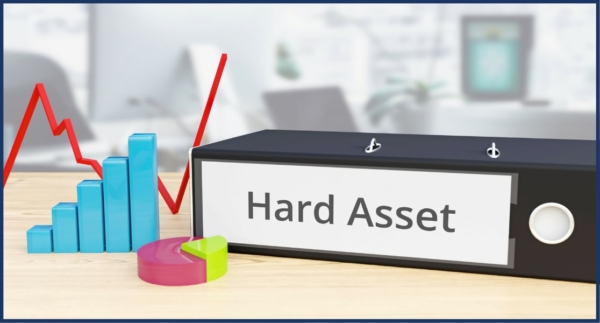
There is great appeal in hard assets to investors that are anxious about inflation and stock market volatility.
What are Hard Assets?
A hard asset is a tangible or physical item or object of worth that is owned by an individual or a corporation. Examples of hard assets are tangible objects such as real estate, oil, gold, or diamonds.
Their chief appeal is that they retain some value no matter how far their market prices may fall.
Similar to real estate and gold, oil prices are consistent with inflation. The increased cost of oil trickles to the price of gasoline. As fuel is imperative to society, consumers have little option but to pay inflated prices.
Due to this demand for oil even during periods of inflation investors are strongly attracted to this investment type.
Hard assets are the opposite of an intangible asset.
An intangible asset is a non-physical item that still has value such as goodwill, investments in securities, a trademark or a patent.
If an investor’s portfolio is primarily composed of intangible assets, the financial security hinges on the value of the nation’s currency. If the currency devalues, so does the portfolio.
How Hard Assets Hold Value
Hard assets tend to hold their value, especially in real estate. Even if a nation’s currency were to disintegrate, there would still be intrinsic value in real estate. Real estate properties are useful and can be exchanged for other items of value.
Intrinsic by its nature, real estate can be traded or sold for things that support and sustain life.
Hard assets are fundamentally valuable because there is limited supply.
Hard assets are an excellent hedge against inflation, meaning their value rises as the general price levels for goods and services increase. This is known as Consumer Price Index or CPI. Over the long-term, real estate is usually an excellent investment response to inflation.
In fact, real estate sometimes sees its greatest price appreciation during periods of high inflation. This is especially true since as rents rise, people become increasingly interested in owning real estate as a way of getting the tax benefits which help offset the general level of inflation.
The key to profiting in an inflationary environment is to hold investments that increase in value at a rate that exceeds the rate of inflation.
Other Examples of Hard Assets
Above, we briefly mentioned hard assets such as real estate, gold, or diamonds. Let’s dive into more hard assets that are valuable.
1. Silver
Though similar to gold, Silver has its own appeal. Silvers holds appeal as a metal, as fashion and is also a worthy hedge against inflation.
2. Platinum
Platinum is unique in it’s value because it has two benefits. It also has strong inflation-fighting abilities, but it’s in high demand for industrial use. Automobile, electronic, and jewelry industry popularly demands the material.
3. Classic Cars
Classic cars can also be considered a hard asset. They are luxury goods that are used for recreation, but they can preserve capital, too. Their limited supply drives up their value, the older and rarer they become.
Sign Up For Our Newsletter
Enjoyed this article? Please share with your community! To receive our monthly articles and updates, sign up for our newsletter.






